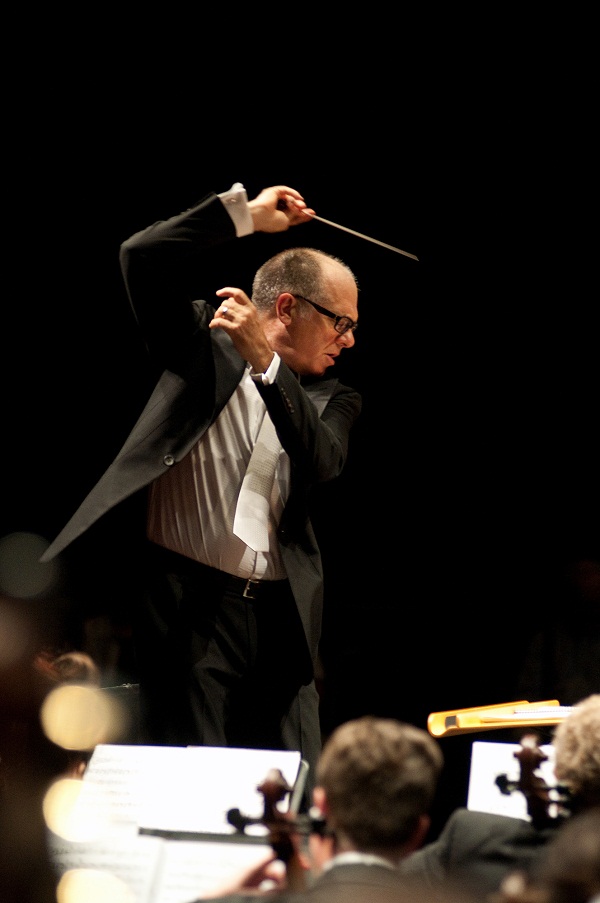The La Jolla Symphony and Chorus Holiday Banquet of New Music and Poulenc’s ‘Gloria’
Because I enjoyed the Met’s recent HD live broadcast of Thomas Adès’ complex, brooding opera The Exterminating Angel, I felt I could not ignore the La Jolla Symphony’s performance of the composer’s Violin Concerto, Op. 23, “Concentric Paths,” at Mandeville Auditorium last weekend. Following his usual penchant for assembling inspired musical collages, Music Director Steven Schick placed the concerto at the center of a richly varied program of new works by young composers Tina Tallon and Felipe Rossi as well as the evergreen Poulenc Gloria.
In retrospect, I was surprised that the Thomas Adès and Francis Poulenc works displayed several traits in common: each is a composition of brilliant concision and a remarkable showpiece for the soloist, and each managed to employ the colors and strength of the orchestra to great advantage. Like his recent opera, Adès’ Violin Concerto progresses through restless, dense textures, with the violin soloist constantly challenging or heightening the unrelenting agitation below him.But Adès has inverted the typical concerto structure, making the middle movement—usually a quiet, sweet interlude between the expansive outer movements that develop a composer’s main themes—the heart of the concerto, reducing the outer movements to short, brilliant frames to his turbulent musical landscape. This middle movement, titled “Paths,” opens with discrete, piquant chords in the brass, to which the soloist issues short, biting challenges, a procedure repeated with the strings taking over the brass function. The paths that follow include poignant slow melodies for the soloist interspersed with turbulent figures in the highest register of the violin.
The young virtuoso Keir GoGwilt tore into Adès’ Byzantine solo violin part with fierce determination and amazingly supple technical finesse, earning wild cheers from the Mandeville audience. In spite of the complexity of the violin solo, GoGwilt maintained a lustrous sonority throughout. Schick conducted the concerto—the intricate type of contemporary score that is his catnip–with his customary precision and cool authority.
Although the Poulenc Gloria is infrequently programmed today, I recall a time a few decades ago when it was a popular cantata that even parish choirs essayed. The La Jolla Symphony and Chorus brought vigor and conviction to Poulenc’s jaunty homage to the 18th-century cantata. This semester marked Patrick Walders’ debut as Choral Director, and I noted an immediate improvement in the warmer and more unified sound of the women’s voices. In the “Domine Deus, Agnus Dei,” they surrounded the soprano soloist Susan Narucki with a celestial aura like the nuns clustered around Sister Blanche in Poulenc’s Dialogues of the Carmelites, the opera he completed a few years before composing the Gloria. It was difficult to discern changes in the quality of the men’s sections because they are seriously overpowered by the size of the women’s sections. The men comprise only one-third of the chorus, an imbalance that needs to be remedied.
Schick’s fast tempos worked splendidly in the sections of the Gloria such as the “Laudamus te” that reflect the composer’s infatuation with the Parisian cabaret music of the 1930s, and his orchestra responded with infectious elan. Narucki’s ardent projection and graceful phrasing made the more reverent “Domine deus” particularly moving. Overall, this was a memorable Poulenc Gloria.
The orchestra also presented UC San Diego music doctoral student Tina Tallon’s “luscinia,” winner of this year’s Thomas Nee Commission. A starkly minimal, though not at all minimalist, single movement tableau, Tallon aptly described her work as “a meditation on silence.” Starting with a startling col legno flourish from the principal contrabass, “luscinia” quietly weaves a web of whispers and murmurs from the strings and grows into soft, bird-like chirpings (the title refers to the nightengale) presumably incarnated by the computer interaction with the orchestra. The composer participated at the computer, today’s equivalent of the 9-foot Steinway.
Perhaps taking a cue from Ottorino Respighi’s Ancient Airs and Dances, Felipe Rossi arranged Guillaume de Machaut’s song “Je vivroie liement” (“I should lead a happy life”) for soprano, violin and orchestra. Kirsten Wiest’s lithe soprano declaimed the 14th-century French poetry sympathetically, aided by GoGwilt’s supple violin obbligato and alert percussion from red fish blue fish. The orchestra played such a minor role in Rossi’s arrangement, it could have been replaced with ease by a string quartet, but it was endearing to hear in the concert hall Machaut’s earthy rhythms and austere harmonies.
Schick opened this musical marathon with Beethoven’s robust but ever dignified “Egmont” Overture; in my opinion, just the right proportion of standard repertory to new music on a program.
The La Jolla Symphony and Chorus presented this program December 9 & 10, 2017 in UC San Diego’s Mandeville Auditorium. The December 10 matinee was attended for this review.

Ken Herman, a classically trained pianist and organist, has covered music for the San Diego Union, the Los Angeles Times’ San Diego Edition, and for sandiego.com. He has won numerous awards, including first place for Live Performance and Opera Reviews in the 2017, the 2018, and the 2019 Excellence in Journalism Awards competition held by the San Diego Press Club. A Chicago native, he came to San Diego to pursue a graduate degree and stayed.Read more…

